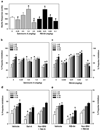Structure-based design, synthesis, and biochemical and pharmacological characterization of novel salvinorin A analogues as active state probes of the kappa-opioid receptor
- PMID: 19555087
- PMCID: PMC2752672
- DOI: 10.1021/bi900605n
Structure-based design, synthesis, and biochemical and pharmacological characterization of novel salvinorin A analogues as active state probes of the kappa-opioid receptor
Abstract
Salvinorin A, the most potent naturally occurring hallucinogen, has attracted an increasing amount of attention since the kappa-opioid receptor (KOR) was identified as its principal molecular target by us [Roth, B. L., et al. (2002) Proc. Natl. Acad. Sci. U.S.A. 99, 11934-11939]. Here we report the design, synthesis, and biochemical characterization of novel, irreversible, salvinorin A-derived ligands suitable as active state probes of the KOR. On the basis of prior substituted cysteine accessibility and molecular modeling studies, C315(7.38) was chosen as a potential anchoring point for covalent labeling of salvinorin A-derived ligands. Automated docking of a series of potential covalently bound ligands suggested that either a haloacetate moiety or other similar electrophilic groups could irreversibly bind with C315(7.38). 22-Thiocyanatosalvinorin A (RB-64) and 22-chlorosalvinorin A (RB-48) were both found to be extraordinarily potent and selective KOR agonists in vitro and in vivo. As predicted on the basis of molecular modeling studies, RB-64 induced wash-resistant inhibition of binding with a strict requirement for a free cysteine in or near the binding pocket. Mass spectrometry (MS) studies utilizing synthetic KOR peptides and RB-64 supported the hypothesis that the anchoring residue was C315(7.38) and suggested one biochemical mechanism for covalent binding. These studies provide direct evidence of the presence of a free cysteine in the agonist-bound state of the KOR and provide novel insights into the mechanism by which salvinorin A binds to and activates the KOR.
Figures






Similar articles
-
Michael acceptor approach to the design of new salvinorin A-based high affinity ligands for the kappa-opioid receptor.Eur J Med Chem. 2014 Oct 6;85:818-29. doi: 10.1016/j.ejmech.2014.07.077. Epub 2014 Aug 23. Eur J Med Chem. 2014. PMID: 25193297 Free PMC article.
-
Differential helical orientations among related G protein-coupled receptors provide a novel mechanism for selectivity. Studies with salvinorin A and the kappa-opioid receptor.J Biol Chem. 2007 Feb 2;282(5):3146-56. doi: 10.1074/jbc.M609264200. Epub 2006 Nov 22. J Biol Chem. 2007. PMID: 17121830
-
Discovery of Novel, Selective, and Nonbasic Agonists for the Kappa-Opioid Receptor Determined by Salvinorin A-Based Virtual Screening.J Med Chem. 2024 Aug 22;67(16):13788-13801. doi: 10.1021/acs.jmedchem.4c00590. Epub 2024 Aug 1. J Med Chem. 2024. PMID: 39088801 Free PMC article.
-
Salvinorin A: the "magic mint" hallucinogen finds a molecular target in the kappa opioid receptor.Trends Pharmacol Sci. 2003 Mar;24(3):107-9. doi: 10.1016/S0165-6147(03)00027-0. Trends Pharmacol Sci. 2003. PMID: 12628350 Review.
-
Chemical syntheses of the salvinorin chemotype of KOR agonist.Nat Prod Rep. 2020 Nov 18;37(11):1478-1496. doi: 10.1039/d0np00028k. Nat Prod Rep. 2020. PMID: 32808003 Free PMC article. Review.
Cited by
-
Natural Products for the Treatment of Pain: Chemistry and Pharmacology of Salvinorin A, Mitragynine, and Collybolide.Biochemistry. 2021 May 11;60(18):1381-1400. doi: 10.1021/acs.biochem.0c00629. Epub 2020 Sep 22. Biochemistry. 2021. PMID: 32930582 Free PMC article. Review.
-
Strategies for Developing κ Opioid Receptor Agonists for the Treatment of Pain with Fewer Side Effects.J Pharmacol Exp Ther. 2020 Nov;375(2):332-348. doi: 10.1124/jpet.120.000134. Epub 2020 Sep 10. J Pharmacol Exp Ther. 2020. PMID: 32913006 Free PMC article. Review.
-
Covalent allosteric modulation: An emerging strategy for GPCRs drug discovery.Eur J Med Chem. 2020 Nov 15;206:112690. doi: 10.1016/j.ejmech.2020.112690. Epub 2020 Aug 9. Eur J Med Chem. 2020. PMID: 32818870 Free PMC article. Review.
-
Neuropharmacology of the naturally occurring kappa-opioid hallucinogen salvinorin A.Pharmacol Rev. 2011 Jun;63(2):316-47. doi: 10.1124/pr.110.003244. Epub 2011 Mar 28. Pharmacol Rev. 2011. PMID: 21444610 Free PMC article. Review.
-
Kappa-opioid receptor-selective dicarboxylic ester-derived salvinorin A ligands.Bioorg Med Chem Lett. 2013 May 15;23(10):2860-2. doi: 10.1016/j.bmcl.2013.03.111. Epub 2013 Apr 4. Bioorg Med Chem Lett. 2013. PMID: 23587424 Free PMC article.
References
-
- Ortega A, Blount JF, Manchand PS. Salvinorin: a new trans-neoclerodane diterpene from Salvia divinorum (Labiatae) J Chem Soc Perkins Trans I. 1982:2505–2508.
-
- Valdes LJ, Butler WM, Hatfield GM, Paul AG, Koreeda M. Divinorin A: a psychotropic terpenoid and divnorin B from the hallucinogenic Mexican mint Salvia divinorum. J Org Chem. 1984;49:4716–7720.
-
- Ansonoff MA, Zhang J, Czyzyk T, Rothman RB, Stewart J, Xu H, Zjwiony J, Siebert DJ, Yang F, Roth BL, Pintar JE. Antinociceptive and hypothermic effects of Salvinorin A are abolished in a novel strain of kappa-opioid receptor-1 knockout mice. J Pharmacol Exp Ther. 2006;318:641–648. - PubMed
-
- Sheffler DJ, Roth BL. Salvinorin A: the "magic mint" hallucinogen finds a molecular target in the kappa opioid receptor. Trends Pharmacol Sci. 2003;24:107–109. - PubMed
Publication types
MeSH terms
Substances
Grants and funding
LinkOut - more resources
Full Text Sources
Other Literature Sources
Research Materials

